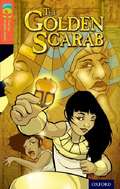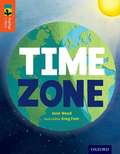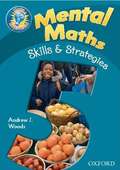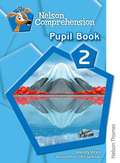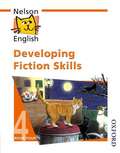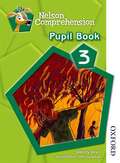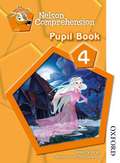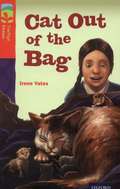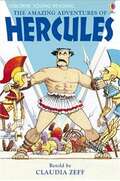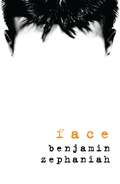- Table View
- List View
Oxford Reading Tree, Level 13, TreeTops Graphic Novels: The Golden Scarab (PDF)
by Barbara WinterBook band 13 grey. Oxford level 13. The Golden Scarab is a detective story set in ancient Egypt. Princess Meri and the rescued slave girl, Layla, don't believe that bad fish is making the Pharaoh ill and they decide to investigate. TreeTops Graphic Novels bring historical periods to life. These 24 action-packed graphic novels combine fiction and non-fiction texts in the one theme - from Vikings to gladiators and pirates to code-breakers. Non-fiction pages throughout give context and add depth to the stories to support comprehensionA different kind of reading challenge to engage your readers, especially the boys. Short captions of text, closely linked to the pictures, are perfect for second-language learners. Incredible stories are woven around amazing characters and events, exciting themes and stunning artwork to engage both independent and reluctant readers. Cross-curricular topics in history and geography stimulate discussion and inspire creative writing.
Oxford Reading Tree, Level 13, TreeTops inFact: Time Zone (PDF)
by Jane WoodBook band 13 grey. Oxford level 13. Meet children from different time zones all around the world in Time Zone. TreeTops inFact is an exciting non-fiction series for children aged 711. Its range of subjects and careful levelling make it easy to select books that children will love.
Maths Inspirations: Teacher's Notes (PDF)
by Andrew J. WoodsProvides opportunities to use and apply mental calculation strategies through sets of graded mental exercises, including a variety of formal questions and informal activities. The series offers ideas for building children's mental maths ability in a structured way. These photocopiable resources provide practice opportunities where they are needed.
Nelson Comprehension: Pupil Book 2 (PDF)
by Wendy WrenA pupil book designed to meet the comprehension needs of the renewed framework and primary children's literacy assessment needs, providing a range of extracts, teaching support, discussion and drama activities and differentiated comprehension questions.
Wellington Square, Level 2, Set B: Get that cat!
by Wendy WrenKevin has a cat in his bag. The cat enjoys the trip to school but Mr Belter and the Head are not so happy! Wellington Square is designed to meet the needs of children aged 7-13+ who are having difficulty in learning to read. It provides straightforward progression through all 5 levels of the scheme, from wordless picture books to storybooks with full-text. Wellington Square widens your pupils' reading experience through imaginative and stimulating support material.
Developing Fiction Skills: Book 4 (PDF)
by Wendy Wren John JackmanThe Developing Fiction Skills and Developing Non-Fiction Skills pupil books explore a wide range of texts using parallel themes. Each book contains twelve units offering four units per term. The parallel themes common to both the Fiction and Non-Fiction strands allow for comparison, an exploration of the same theme in different text types and effectively integrates the teaching of non-fiction.
Nelson Comprehension: Pupil Book 3 (PDF)
by Wendy Wren John JackmanA pupil book designed to meet the comprehension needs of the renewed framework and primary children's literacy assessment needs, providing a range of extracts, teaching support, discussion and drama activities and differentiated comprehension questions.
Nelson Comprehension: Pupil Book 4 (PDF)
by Wendy Wren John JackmanA pupil book designed to meet the comprehension needs of the renewed framework and primary children's literacy assessment needs, providing a range of extracts, teaching support, discussion and drama activities and differentiated comprehension questions.
Oxford Reading Tree, Level 13, TreeTops Fiction, Pack B: Cat Out of the Bag (2014 edition) (PDF)
by Irene YatesBook band 13 grey. Oxford level 13, pack B. Kirandip is sure that she saw a cat in the window of Mrs Weston's house in Cat Out of the Bag. But everyone knows pets aren't allowed and Mrs Weston says there isn't a cat. Then Kirandip hears a strange noise. . . TreeTops Fiction is a series of funny, age-appropriate stories with wide appeal to both girls and boys. These motivating chapter books with engaging colour illustrations build stamina, fluency and comprehension across a rich range of vocabulary. Ideal for independent reading, the wide variety ensures there's something for every young student to enjoy, including humour, sci-fi, adventure, mystery and historical fiction. Levelled to provide clear and gradual progression with carefully controlled words per page. Written by leading children's authors who offer truly boy-friendly stories with gripping plots. Alternate ISBN 9780199183999
Face
by Benjamin ZephaniahMartin was on top of the world. His credibility was sealed and Natalie was proud of him. If there's one thing that Martin is sure about, it's that life is pretty good to him. But life - as Martin is about to find out - has a habit of throwing the unexpected at you. At this point Martin knew something terrible had happened to his face. His heart pounded in his chest. He shifted his eyes to the left and saw his father standing over him 'Are you OK, son?' Martin's life is about to change forever. In his debut novel, poet Benjamin Zephaniah tackles the story of a young man whose life is completely changed when his face is badly scarred in a joyriding accident.
Butterfly lifecycle 1 (eggs and hatching) (Large Print)
This image shows a scale, an egg, a hatched egg and a newly emerged caterpillar. There is a locator dot shown, which will be at the top left of the page when the image is the right way up. The scale is on the left of the page. To its right is the dark green egg with pale vertical grooves. To the right of this is another egg which is broken open at the top. On the right of the page is the small pale green caterpillar with its head on the right and its anal clasper to the left. Its head has one of its two large eyes showing and one of its two antennae above it. It has a hairy back. Three of its six thoracic legs are to the right and four of its eight stumpy prolegs are to the left.
Butterfly lifecycle 1 (eggs and hatching) (UEB Contracted)
This image shows a scale, an egg, a hatched egg and a newly emerged caterpillar. There is a locator dot shown, which will be at the top left of the page when the image is the right way up. The scale is on the left of the page. To its right is the dark green egg with pale vertical grooves. To the right of this is another egg which is broken open at the top. On the right of the page is the small pale green caterpillar with its head on the right and its anal clasper to the left. Its head has one of its two large eyes showing and one of its two antennae above it. It has a hairy back. Three of its six thoracic legs are to the right and four of its eight stumpy prolegs are to the left.
Butterfly lifecycle 1 (eggs and hatching) (UEB Uncontracted)
This image shows a scale, an egg, a hatched egg and a newly emerged caterpillar. There is a locator dot shown, which will be at the top left of the page when the image is the right way up. The scale is on the left of the page. To its right is the dark green egg with pale vertical grooves. To the right of this is another egg which is broken open at the top. On the right of the page is the small pale green caterpillar with its head on the right and its anal clasper to the left. Its head has one of its two large eyes showing and one of its two antennae above it. It has a hairy back. Three of its six thoracic legs are to the right and four of its eight stumpy prolegs are to the left.
Butterfly lifecycle 2 (caterpillar) (Large Print)
The mature dark grey green caterpillar is shown from the side with its head to the right and a scale at the bottom of the page. There is a locator dot shown, which will be at the top left of the page when the image is the right way up. Its head has one of its two large eyes showing and one of its two antennae above it. Below the eye is one of its mouth parts. It is a hairy caterpillar with spiky hairs on its back and sides. Three of its six thoracic legs are to the right and four of its eight prolegs are to the left. Just above the legs running the length of the caterpillar is a wavy yellow line. The caterpillar ends on the left with its anal clasper.
Butterfly lifecycle 2 (caterpillar) (UEB Contracted)
The mature dark grey green caterpillar is shown from the side with its head to the right and a scale at the bottom of the page. There is a locator dot shown, which will be at the top left of the page when the image is the right way up. Its head has one of its two large eyes showing and one of its two antennae above it. Below the eye is one of its mouth parts. It is a hairy caterpillar with spiky hairs on its back and sides. Three of its six thoracic legs are to the right and four of its eight prolegs are to the left. Just above the legs running the length of the caterpillar is a wavy yellow line. The caterpillar ends on the left with its anal clasper.
Butterfly lifecycle 2 (caterpillar) (UEB Uncontracted)
The mature dark grey green caterpillar is shown from the side with its head to the right and a scale at the bottom of the page. There is a locator dot shown, which will be at the top left of the page when the image is the right way up. Its head has one of its two large eyes showing and one of its two antennae above it. Below the eye is one of its mouth parts. It is a hairy caterpillar with spiky hairs on its back and sides. Three of its six thoracic legs are to the right and four of its eight prolegs are to the left. Just above the legs running the length of the caterpillar is a wavy yellow line. The caterpillar ends on the left with its anal clasper.
Butterfly lifecycle 3 (pupa) (Large Print)
The pupa has its head to the right of the page and the tail end to the left. At the bottom of the page is a scale. There is a locator dot shown, which will be at the top left of the page when the image is the right way up. In the right centre of the image the circular shape of the covered eye can be found. Down from this is a covered antenna which goes left to the centre of the pupa. The large triangular area on the right of the pupa is where the wing is developing. The left half of the pupa is its developing abdomen with a small spiracle in the centre of each segment allowing it to breathe. Towards the top of each segment is a small decorative golden stud.
Butterfly lifecycle 3 (pupa) (UEB Contracted)
The pupa has its head to the right of the page and the tail end to the left. At the bottom of the page is a scale. There is a locator dot shown, which will be at the top left of the page when the image is the right way up. In the right centre of the image the circular shape of the covered eye can be found. Down from this is a covered antenna which goes left to the centre of the pupa. The large triangular area on the right of the pupa is where the wing is developing. The left half of the pupa is its developing abdomen with a small spiracle in the centre of each segment allowing it to breathe. Towards the top of each segment is a small decorative golden stud.
Butterfly lifecycle 3 (pupa) (UEB Uncontracted)
The pupa has its head to the right of the page and the tail end to the left. At the bottom of the page is a scale. There is a locator dot shown, which will be at the top left of the page when the image is the right way up. In the right centre of the image the circular shape of the covered eye can be found. Down from this is a covered antenna which goes left to the centre of the pupa. The large triangular area on the right of the pupa is where the wing is developing. The left half of the pupa is its developing abdomen with a small spiracle in the centre of each segment allowing it to breathe. Towards the top of each segment is a small decorative golden stud.
Butterfly lifecycle 4 (adult emerges from pupa) (Large Print)
This image shows an opened pupa hanging on the left and in the centre of the page is the recently emerged adult hanging onto the right side of the pupa. There is a locator dot shown, which will be at the top left of the page when the image is the right way up. Its head is in the top centre and the tail in the bottom centre of the page. They are surrounded by an image border. The empty casing of the pupa hangs head down with the bottom half opened up. At the top centre of the page is the end of one of the adult's two antennae, it is still soft from being in the pupa and has not yet straightened and stiffened. To the left of the base of the antenna one of its two large eyes is showing on its head. Down from the head is the thorax with two of its four wrinkled wings sticking out to the right. The upper, larger fore wing has an orange band in the middle and two white spots in the top centre. The smaller hind wing is down from this and has an orange edge on the right. Three of its six multi-jointed legs are to the left of the abdomen, which it uses to hold onto the pupa. Down from this is the segmented abdomen.
Butterfly lifecycle 4 (adult emerges from pupa) (UEB Contracted)
This image shows an opened pupa hanging on the left and in the centre of the page is the recently emerged adult hanging onto the right side of the pupa. There is a locator dot shown, which will be at the top left of the page when the image is the right way up. Its head is in the top centre and the tail in the bottom centre of the page. They are surrounded by an image border. The empty casing of the pupa hangs head down with the bottom half opened up. At the top centre of the page is the end of one of the adult's two antennae, it is still soft from being in the pupa and has not yet straightened and stiffened. To the left of the base of the antenna one of its two large eyes is showing on its head. Down from the head is the thorax with two of its four wrinkled wings sticking out to the right. The upper, larger fore wing has an orange band in the middle and two white spots in the top centre. The smaller hind wing is down from this and has an orange edge on the right. Three of its six multi-jointed legs are to the left of the abdomen, which it uses to hold onto the pupa. Down from this is the segmented abdomen.
Butterfly lifecycle 4 (adult emerges from pupa) (UEB Uncontracted)
This image shows an opened pupa hanging on the left and in the centre of the page is the recently emerged adult hanging onto the right side of the pupa. There is a locator dot shown, which will be at the top left of the page when the image is the right way up. Its head is in the top centre and the tail in the bottom centre of the page. They are surrounded by an image border. The empty casing of the pupa hangs head down with the bottom half opened up. At the top centre of the page is the end of one of the adult's two antennae, it is still soft from being in the pupa and has not yet straightened and stiffened. To the left of the base of the antenna one of its two large eyes is showing on its head. Down from the head is the thorax with two of its four wrinkled wings sticking out to the right. The upper, larger fore wing has an orange band in the middle and two white spots in the top centre. The smaller hind wing is down from this and has an orange edge on the right. Three of its six multi-jointed legs are to the left of the abdomen, which it uses to hold onto the pupa. Down from this is the segmented abdomen.
Butterfly lifecycle 5 (adult fills and dries wings) (Large Print)
This image shows the butterfly viewed from the side with its head on the right and its tail on the left. There is a locator dot shown, which will be at the top left of the page when the image is the right way up. On the right one of its two large eyes is showing with one of its two antennae above it. To the left of the head is the thorax with two of its four wings sticking up. To the right is the fore wing with two patches of orange in the centre and up from them, two white spots. The hind wing is to the left, it has a silver spot near the thorax and a grey band on the edge to the left. The wings are still soft bags which will flatten as the veins fill and stretch them flat and hard. Left from this is the segmented abdomen. Three of its six multi-jointed legs can be found, upon which it stands.
Butterfly lifecycle 5 (adult fills and dries wings) (UEB Contracted)
This image shows the butterfly viewed from the side with its head on the right and its tail on the left. There is a locator dot shown, which will be at the top left of the page when the image is the right way up. On the right one of its two large eyes is showing with one of its two antennae above it. To the left of the head is the thorax with two of its four wings sticking up. To the right is the fore wing with two patches of orange in the centre and up from them, two white spots. The hind wing is to the left, it has a silver spot near the thorax and a grey band on the edge to the left. The wings are still soft bags which will flatten as the veins fill and stretch them flat and hard. Left from this is the segmented abdomen. Three of its six multi-jointed legs can be found, upon which it stands.
